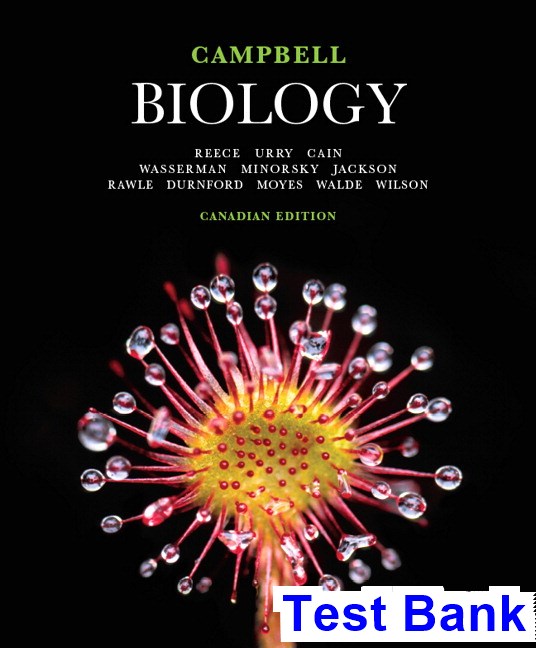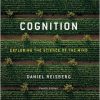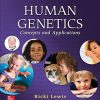Campbell Biology Canadian 1st Edition Reece Test Bank
$35.00 Original price was: $35.00.$26.50Current price is: $26.50.
Campbell Biology Canadian 1st Edition Reece Test Bank
Instant download Campbell Biology Canadian 1st Edition Reece Test Bank pdf docx epub after payment.

Product details:
- ISBN-10 : 0321778308
- ISBN-13 : 978-0321778307
- Author: Steven Wasserman
Campbell BIOLOGY is the best-selling introductory biology text in Canada. The text is written for university biology majors and is unparalleled with respect to its accuracy, depth of explanation, and art program, as well as its overall effectiveness as a teaching and learning tool.
Table of contents:
Concept 1.2 The Core Theme: Evolution accounts for the unity and diversity of life
Concept 1.3 In studying nature, scientists make observations and form and test hypotheses
Concept 1.4 Science benefits from a cooperative approach and diverse viewpoints
Unit 1 THE ROLE OF CHEMISTRY IN BIOLOGY
2 Atoms and Molecules
A Chemical Connection to Biology
Concept 2.1 Matter consists of chemical elements in pure form and in combinations called compounds
Concept 2.2 An element’s properties depend on the structure of its atoms
Concept 2.3 The formation and function of molecules depend on chemical bonding between atoms
Concept 2.4 Chemical reactions make and break chemical bonds
3 The Chemistry of Water
The Molecule That Supports All of Life
Concept 3.1 Polar covalent bonds in water molecules result in hydrogen bonding
Concept 3.2 Four emergent properties of water contribute to Earth’s suitability for life
Concept 3.3 Acidic and basic conditions affect living organisms
4 Carbon: The Basis of Molecular Diversity
Carbon: The Backbone of Life
Concept 4.1 Organic chemistry is the study of carbon compounds
Concept 4.2 Carbon atoms can form diverse molecules by bonding to four other atoms
Concept 4.3 A few chemical groups are key to molecular function
5 Biological Macromolecules and Lipids
The Molecules of Life
Concept 5.1 Macromolecules are polymers, built from monomers
Concept 5.2 Carbohydrates serve as fuel and building material
Concept 5.3 Lipids are a diverse group of hydrophobic molecules
Concept 5.4 Proteins include a diversity of structures, resulting in a wide range of functions
Concept 5.5 Nucleic acids store, transmit, and help express hereditary information
Concept 5.6 Genomics and proteomics have transformed biological inquiry and applications
6 Energy and Life
The Energy of Life
Concept 6.1 An organism’s metabolism transforms matter and energy, subject to the laws of thermodynamics
Concept 6.2 The free-energy change of a reaction tells us whether or not the reaction occurs spontaneously
Concept 6.3 ATP powers cellular work by coupling exergonic reactions to endergonic reactions
Concept 6.4 Enzymes speed up metabolic reactions by lowering energy barriers
Concept 6.5 Regulation of enzyme activity helps control metabolism
Unit 2 Cell biology
7 Cell Structure and Function
The Fundamental Units of Life
Concept 7.1 Biologists use microscopes and biochemistry to study cells
Concept 7.2 Eukaryotic cells have internal membranes that compartmentalize their functions Concept 7.3 The eukaryotic cell’s genetic instructions are housed in the nucleus and carried out by the ribosomes
Concept 7.4 The endomembrane system regulates protein traffic and performs metabolic functions
Concept 7.5 Mitochondria and chloroplasts change energy from one form to another
Concept 7.6 The cytoskeleton is a network of fibers that organizes structures and activities in the cell
Concept 7.7 Extracellular components and connections between cells help coordinate cellular activities
Concept 7.8 A cell is greater than the sum of its parts
8 Cell Membranes
Life at the Edge
Concept 8.1 Cellular membranes are fluid mosaics of lipids and proteins
Concept 8.2 Membrane structure results in selective permeability
Concept 8.3 Passive transport is diffusion of a substance across a membrane with no energy investment
Concept 8.4 Active transport uses energy to move solutes against their gradients
Concept 8.5 Bulk transport across the plasma membrane occurs by exocytosis and endocytosis
9 Cellular Signaling
Cellular Messaging
Concept 9.1 External signals are converted to responses within the cell
Concept 9.2 Reception: A signaling molecule binds to a receptor protein, causing it to change shape
Concept 9.3 Transduction: Cascades of molecular interactions relay signals from receptors to target molecules in the cell
Concept 9.4 Response: Cell signaling leads to regulation of transcription or cytoplasmic activities
Concept 9.5 Apoptosis integrates multiple cell-signaling pathways
10 Cell Respiration
Life Is Work
Concept 10.1 Catabolic pathways yield energy by oxidizing organic fuels
Concept 10.2 Glycolysis harvests chemical energy by oxidizing glucose to pyruvate
Concept 10.3 After pyruvate is oxidized, the citric acid cycle completes the energy-yielding oxidation of organic molecules
Concept 10.4 During oxidative phosphorylation, chemiosmosis couples electron transport to ATP synthesis
Concept 10.5 Fermentation and anaerobic respiration enable cells to produce ATP without the use of oxygen
Concept 10.6 Glycolysis and the citric acid cycle connect to many other metabolic pathways
People also search:
Campbell Biology Canadian 1st Edition
Campbell Biology Canadian 1st Edition pdf
Campbell Biology Canadian
campbell biology canadian edition
campbell biology answer key
Related products
Test Bank
Test Bank for Essentials of Business Law and the Legal Environment, 11th Edition: Richard A. Mann
Test Bank
Test Bank for Decision Support and Business Intelligence Systems, 9th Edition: Efraim Turban











